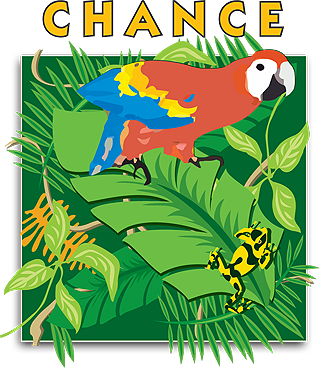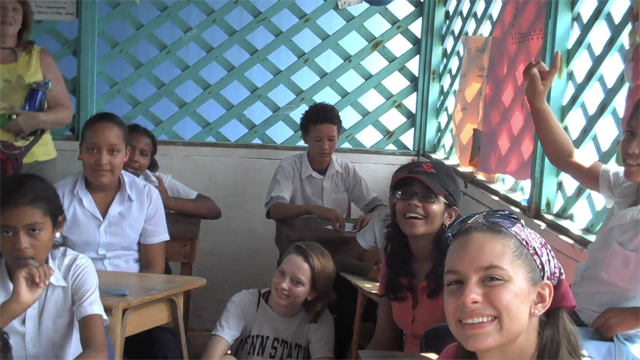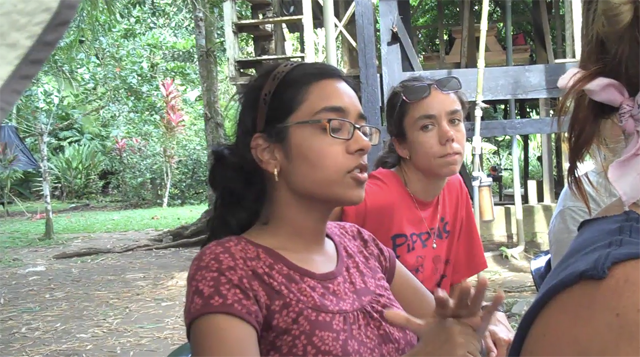Key Takeaways
- Technology can enable experiential teaching and learning in the 21st century classroom, making science education more rigorous, relevant, and based on relationships that extend beyond academic walls.
- Programs that link skilled educators and research scientists with teachers and students, either virtually or in the field, can use technology to build new and effective multimedia learning environments and strategies for effective science teaching and learning.
- The CHANCE program blends research with teaching as the most effective vehicle for developing true scientific understanding — vital knowledge for the world community now and in the future.
The future of higher education in the sciences will be marked by programs that link skilled educators and research scientists from around the world with teachers for professional development and with students for high-impact learning — either virtually or physically in the field. These programs will use technology where possible to build new and effective multimedia learning environments and strategies that transition students out of simple inquiry-based learning tools (textbooks and PowerPoint slides, for example, or “drill and practice” paradigms) and toward professional science practice itself (research, more student responsibility, problem-solving paradigms that focus on student understanding and application of knowledge). In 21st century science classrooms, the power of experiential teaching and learning, in which the use of technology replaces in-class lectures or readings and color-coded diagrams from a textbook as the medium of experience, will prevail. Because of this, science education will be more rigorous, relevant, and based on relationships with stakeholders beyond the confines of academic walls.
Blending Research with Teaching
I believe that student research is the most effective vehicle for developing true scientific understanding. Thus, I have spent my academic life transforming the textbook method of teaching biology into dynamic pedagogical methods of learning that immerse students in biological concepts and real-world issues by engaging them directly in research. Whether I’m in my “physical classroom” at Penn State Lehigh Valley or in my “field classrooms,” I know that by blending research with teaching I’ve helped open my students’ eyes, allowing them to view the biodiversity of our living world from a research perspective. The flagship element of this teaching method is a professional development program I founded and direct, called CHANCE, for Connecting Humans and Nature through Conservation Experiences (see Figure 1). The program focuses on:
- Enhancing the training of high school science teachers in environmental science and conservation biology
- Using hands-on scientific field experience in Costa Rica/Panama (and soon, China) and computer-based, interactive research modules to bring real-world scientific issues, research methods, and data into classrooms
- Training high-school and pre-service science teachers to use the research modules, which can be freely accessed by all educators, to enhance their environmental science curricula
The use of technology is the catalyst that allows CHANCE to empower biology teachers to:
- Create interactive classrooms for active learning
- Help students construct knowledge
- Bring cutting-edge research to their lessons
- Help excite the next generation of researchers and citizens,
- Support experiential learning and worldwide collaboration in that learning
CHANCE also empowers students to go beyond the core content found in textbooks and consider the implications of real-world research evidence, data, and interpretations they analyze either virtually or in the field. Students are encouraged to look at both local and global situations and to engage intelligently in public debate about matters of scientific and technological concern. In these ways, biology students engage in the most effective active learning methods.1
Making Connections in CHANCE
The objective of the CHANCE program reflects its name: connecting humans and nature through conservation experiences. Under the umbrella of conservation, high school teachers and Penn State undergraduates experience and connect with the biodiversity that defines the biosphere of our living planet (see “What Is CHANCE?”). The connections that CHANCE forges between teachers and learners from high schools and colleges, drawing on a wide range of talents and interests, are an important consideration for the future of higher education. These connections develop new educational structures that break down barriers between disciplines and the long-lived academic configurations of American university and high school education. Additionally, they help many students make the transition to college.
Initiated in 2004, the CHANCE program is a partnership between The Pennsylvania State University and the Pennsylvania Department of Education and has had additional funding streams since it originated. It was developed to enhance teaching and learning of environmental science and ecology within Pennsylvania high school and college undergraduate classrooms. The program accomplishes this through both experiential and technology-assisted forms of active learning: hands-on field research in selected ecosystems in Costa Rica/Panama; and the use of “research modules” to bring real-world scientific data into the classroom. This is further explained in the following brief video.
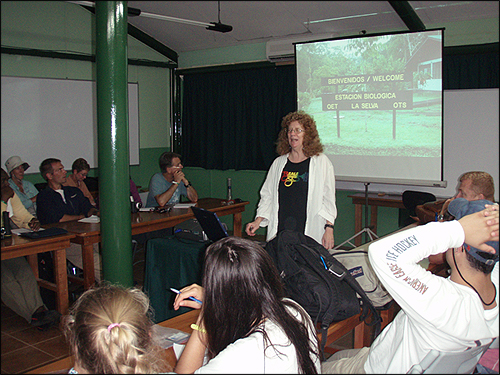
© 2009 Penn State Lehigh Valley
My goal in this article is to illustrate the ways in which the CHANCE program enhances scientific understanding through a combination of active learning techniques centered on scientific research. I will provide an overview of the field course model, the modules and their development, and data supporting the effectiveness of each.
The Field Course — A Proven Model
One key element of active learning in the CHANCE program is the experiential field course, a yearly academic venture to the Central American rainforest and beaches. The actual trip (practicum) entails visiting three renowned nongovernmental organizations — The Organization of Tropical Studies (OTS) in La Selva, Costa Rica; The Smithsonian Tropical Research Institute in Bocas del Toro, Panama; and Widecast (Duke University) in Gandoca, Costa Rica — venturing into the field, analyzing conservation issues, and experiencing what field researchers are actually doing to sustain biodiversity via hands-on research.
Importantly, the required pre-trip, trip, and post-trip assignments are grounded on proven pedagogical practices. The CHANCE field course strictly employs the Field Course Experiential Learning Model,2 which evolved from repeated short-term study abroad (embedded) field course experiences in selected biomes over a six-year period. Assessment of student learning guided the development of the integrated three-part course model, including pre-trip assignments, a field-based trip experience, and post-trip assignments that encourage the integration and application of what students have learned.3
The main objective is to move students beyond simple memorization of facts to higher-order domains of application and integration.4 For this reason, the course has embedded performance assessments that require students to perform authentic tasks to demonstrate knowledge and skills, demonstrating the ability to apply conceptual understanding. For example, students keep daily journals similar to field journals used by scientists to organize and document field observations (see “Assessments of Unstructured Journal Entries”). This authentic assessment replicates scientists’ journal activity while encouraging — and providing evidence of — higher-order thinking.5 Journal assessment is supplemented by a post-trip assignment in which students provide open-ended responses to questions. This assignment helps students connect required pre-trip readings with their field experiences and provides an opportunity to demonstrate their level of learning. Students also lead discussion sessions, give presentations on course-related topics researched during the pre-trip segment, and present actual data gathered and interpreted while in the field doing research.
Self-Assessments of Field-Based Learning
A “Student Assessment of Learning Gains” was also developed as an indirect measure of student learning. This instrument asks high school, undergraduate, and graduate students to rate and verbally elaborate on the extent to which specific learning activities contributed to specific knowledge and skill outcomes. For example, students are asked to rate the extent to which the field experience contributed to their understanding of basic principles of biodiversity, the relationship between human activity and the environment, and other general biological concepts. Similar questions explore how the experience contributed to gains in scientific and higher-order cognitive skills. Assessment findings from three cohorts of undergraduate students (62 participants total, from three courses held during three consecutive summers) participating in the Costa Rica field course showed students reporting cognitive and affective learning gains in all learning activities evaluated.6 (See Tables 1 through 3.) Additionally, data revealed that problem-centered field experiences enhanced the students’ self-assessed knowledge of biodiversity, increased their understanding of how humans impact ecosystems, and influenced how they would make behavioral decisions relative to biodiversity in the future.
Table 1. Student-Reported Gains in Knowledge*
| Knowledge Gained | Rating | Standard Deviation |
| Basic principles of biodiversity | 4.71 | 0.45 |
| How human activities impact biodiversity and ecosystem stability | 5.00 | 0.00 |
| Culture and geography of Costa Rica | 4.43 | 0.73 |
| Conservation biology as it relates to Costa Rica | 4.71 | 0.45 |
| Conservation biology in general | 4.43 | 0.73 |
| Biocomplexity of ecosystems | 4.43 | 0.73 |
| Community ecology | 4.29 | 1.03 |
* Uses a Likert scale of 1 = no gain through 5 = very significant gain in knowledge.
Table 2. Student-Reported Gains in Skills*
| Skills Gained** | Rating | Standard Deviation |
| Applying basic biological principles to field study | 4.57 | 0.49 |
| Communicating through writing | 3.63 | 1.29 |
| Conducting field research | 4.16 | 0.46 |
| Presenting information effectively to others | 4.31 | 1.17 |
| Working as a team to increase learning | 4.44 | 0.64 |
* Uses a Likert scale of 1 = no gain through 5 = very significant gain in skills.
** Students gave slightly lower ratings on skill gains, perhaps due in part to the collaborative nature of the field work: they might not have perceived that they were doing independent work and developing specific individual skills. Their journal entries indicated some possible confusion about this.
Table 3. Student-Reported Gains in Conceptual Learning
| Conceptual Learning Gains | Rating | Standard Deviation |
| Understanding the concepts of biodiversity as they relate to tropical rain forests | 4.57 | 0.49 |
| Understanding how human and social activity impacts biodiversity | 4.57 | 0.49 |
| Understanding how societal decision making alters biodiversity | 4.43 | 0.73 |
| Ability to make informed decisions on ecological issues | 4.57 | 0.49 |
| Thinking critically about complex conservation issues | 4.43 | 0.73 |
| Ability to think through a problem or argument as it pertains to the environment | 4.14 | 0.83 |
* Uses a Likert scale of 1 = no gain through 5 = very significant gain in conceptual learning.
While these indirect quantitative data focus narrowly on the students’ self-reported responses to their CHANCE experiences, qualitative feedback from graduate students who participated in the CHANCE program as in-service teachers have provided more holistic feedback in numerous follow-up evaluations. The following quotes are representative:
“First, the experience of field work in Costa Rica has helped invigorate me in the classroom; second, the wealth of experiences, pictures, knowledge, and research picked up during the trip (and in the accompanying assignments) has provided me with tons of new material for my classroom; and third, the available modules are helping me integrate interactive technology into my classes as well as being valuable curricular material in their own right.” — RB, CHANCE 2007
“When I went to Costa Rica as part of the CHANCE program, I had just graduated college and was about to embark on my first year of teaching 8th grade science. Looking back, my experiences doing the field research with Costa Rica’s rich beauty [...] truly molded my teaching philosophy. The wonderment and excitement I felt made me want to recreate that for my students. If I could evoke these same kinds of emotions and inspiration in my students, they would learn. Bringing biodiversity and inquiry to my classroom through the CHANCE program has been the most influential part of my teaching career.” — JP, CHANCE 2004
“I am a high school Biology and AP Environmental Science teacher. The CHANCE program was the BEST professional development program that I have participated in, in over 20 years of teaching. The interactive approach to Conservation Biology, integrating research, was invaluable. I learned the importance of providing my high school students with this skill, and the modules make this task truly possible. In addition, seeing, feeling, touching, participating in programs in Costa Rica was absolutely a life-changing experience that I bring to my classroom every day.” — PW, CHANCE 2007
One additional form of indirect, overall student assessment of the CHANCE program’s 2009 participants is available in the following videos:
Students from undergraduate through graduate school agree that the CHANCE field-course experiential learning model worked for them. By integrating curricular design and assessment, CHANCE promotes disciplinary learning gains in short-term study abroad (embedded) courses. Incorporating active learning in the design of such courses through pre-trip, trip, and post-trip activities allows faculty to maximize the value of the field experience and document student learning gains. While the CHANCE project has not compared the direct learning outcomes of field-based versus traditional textbook lecture and recitation classes, the next phase of the project, the CHANCE technology-enhanced modules, does compare these methods to demonstrate clear learning gains.
Understanding that every educational environment does not permit international travel to remote research facilities, I worked for the past five years with small teams of one to two instructional designers and rotating cohorts of in-service science teachers to develop an online companion set of CHANCE modules to allow students to carry out real research similar to that experienced by CHANCE field-course participants.
The CHANCE Modules — Structure and Development
Found on the CHANCE website, these interactive learning modules put students and teachers in the field without having to leave the classroom. Each module features a student-as-researcher approach through student manipulation of a data set contributed by scientists currently investigating the same topic. Each module has its own unique objectives, including interactive on-screen research, comprehensive questions in a progressive notebook, and even videos. The CHANCE research modules are recommended by the Pennsylvania Department of Education as a way of helping high school students meet the state standards in environmental science and ecology. Figure 2 shows a list of modules available.
Figure 2. CHANCE Modules Available Online
For an in-depth look at module activity, read the following description of how, in the “Global Warming: Turning Up the Heat” module, multimedia instructional technology was used to simulate Dr. Deborah Clark’s actual field research. Then visit page 5 of this module to see it in action.
After locating Costa Rica and Puerto Viejo on an interactive map, users are welcomed to the LaSelva Research Station — taking in the sights and sounds of the rain forest as they learn more about this private biological reserve, one of the most important research sites in the world for studying the rainforest. Students then get to meet Dr. Clark, learn about her “Trees Project” on the [e]ffect of temperature on tree productivity, her research methods, and how she and her staff monitor over 2000 canopy trees in old-growth lowland rainforest. After being shown how to use a virtual diameter tape measure, they begin the research activity by virtually measuring the diameter and growth change of trees over a span of 15 years, and recording measurements in a table. Finally, they plot the table data on a graph, calculate a growth median, and compare it to the actual graph data set that Dr. Clark published in her research paper (PNAS). From interpreting this data, students discover that while canopy temperature has been increasing in the La Selva rainforest, tree growth (girth) has been decreasing.
Clark’s research is adapted in one of seven CHANCE modules already developed and in use by high schools and educational organizations throughout the world (see the list of partners, sponsors, and collaborators on the CHANCE website.) These modules focus on the following global topics: invasive plant species; raptor migration; amphibians as indicators of environmental change; sea turtle nesting behaviors and survival; deciduous forest biodiversity; species extinction; and global climate change (Figure 2).
Each module maximizes classroom functionality. In addition to an animated research scenario, the modules’ template includes links to teacher guidelines; state and national standards; suggested websites; and ideas for alternative creative, collaborative, and experiential classroom activities. Exclusive to these interactive modules is the CHANCE “Progressive Notebook,” which allows students to continually record their experimental research findings as they progress through the module — observing and carrying out a virtual experiment — in the manner of a researcher collecting data.
Notably, each module is developed through an intricate collaboration between teachers, one or more prominent scientists, the CHANCE program director, a research institution, a governmental or a nongovernmental organization, and instructional technology experts. This partnership ensures that the final products provide a valid representation of cutting-edge scientific research, address the most recent pedagogical practices in science education, and use effective and engaging multimedia instructional technology from animations, videos, and virtual explorations to allow students to explore, critically think about, and understand key environmental science issues and biological concepts.
The CHANCE modules are freely available to anyone in the world teaching high school or undergraduate entry-level biology or environmental science, or to any graduate science education instructor looking for an engaging alternative to teaching basic biological and ecological principles and environmental issues while advocating environmental stewardship. Dialogue among educators is encouraged; teachers and their students can contact the module authors, the research scientists, and the CHANCE director via direct links.
Essentially, the CHANCE modules allow scientists from all over the world to work with students remotely and to share their experiences and thought processes when performing their research. Indeed, as Robert DeHaan reported in his noteworthy review of the state of science education in the United States, “Using real-research strategies to teach has profound effects on student learning, and could have profound effects in promoting a scientifically literate society and a reinvigorated research enterprise.”7
The CHANCE team believes that only a well-informed citizenry will be qualified to create policies and develop programs to help stem the extensive alteration of our natural world. Publishing data in a peer-reviewed journal article is important, yet only a few people can read and understand targeted and complex data. By conveying complex, research-based data tailored to high school and undergraduate students, CHANCE challenges them to think about real-world questions in the manner of scientists. Assisting in that process is one of the most worthwhile endeavors that scientists can undertake, for today’s students will be charged tomorrow with building upon what they learn in science classrooms.
The Modules — Direct Evidence of Success in the Classroom
Recent research8 supports the effectiveness of the CHANCE modules over more traditional instruction methods. This research compared six high school classes in three different Pennsylvania high schools using traditional textbook lecture and recitation methods to six classes using the CHANCE modules to teach a biology unit on ecology (covering similar core concepts and standards). Figure 3 shows the test results for the textbook and module groups (n = 212, with 115 students total in the textbook groups and 97 students total in the module groups); Table 4 shows the mean, standard deviation, statistical significance, and confidence levels for the test results shown in Figure 3. The results in Figure 3 and Table 4 reveal a statistically significant difference between the pre- and post-test scores of the two groups. Both groups were tested before beginning study of the scheduled ecology unit; following study of the ecology unit topics covered in chapters 4, 5, and 6 in the course textbook; and three months after the ecology unit concluded.
Data analysis revealed that between the pre- and post-tests, the student participants who used the CHANCE modules as the primary mode of learning instead of the textbook scored higher on concept assessments given for the content in each chapter. Post-test scores for the module group showed a gain of 12.99 percentage points, while the textbook group showed a gain of 5.91 percentage points. A t-test evaluating the difference in the final post-test scores between the textbook and module groups indicated statistical significance at the p = 0.001 level (Table 4 and Figure 3). Importantly, both student populations showed no significant difference at the pre-assessment stage (the groups varied by only 1.91 percentage points), suggesting that both groups possessed similar academic ability.
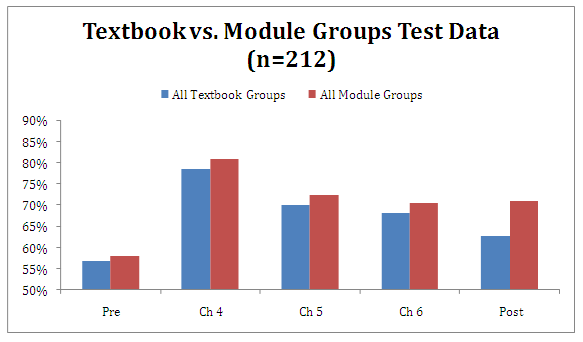
Figure 3. Textbook vs. Module Groups Test Data
Table 4. Statistical Data for High School Group Tests
| No. of Students | Mean Grade | Standard Deviation | t | p-value | |
| Textbook Groups Pre-test | 115 | 55.792 | 4.048 | 0.896 | 0.186 |
| Module Groups Pre-test | 97 | 57.708 | 3.638 | ||
| Text Groups Post-test | 115 | 63.107 | 3.666 | 3.114 | 0.001 |
| Module Groups Post-test | 97 | 69.937 | 4.222 |
Self-Assessments of Module-Based Learning
The same group of high school students also completed pre and post attitudinal surveys to assess their attitudes toward learning science, doing research, and using technology. Overall, student data reveal that today’s youth have positive attitudes toward learning about science and understanding how research is conducted. The surveys also assess students’ perceptions of textbooks. In post-survey responses to the statement “I find my biology textbook interesting,” 52 percent of the students disagreed. Yet, in response to the statement “I feel comfortable using computer-based resources as learning tools,” 81 percent of the students agreed. This information stresses the notion that this generation of youth considers technology part of their daily life. Figure 4 shows student responses to the survey questions posed to students following conclusion of the ecology unit part of the course. The survey used a Likert scale ranging from 1 = Strongly Disagree to 5 = Strongly Agree.
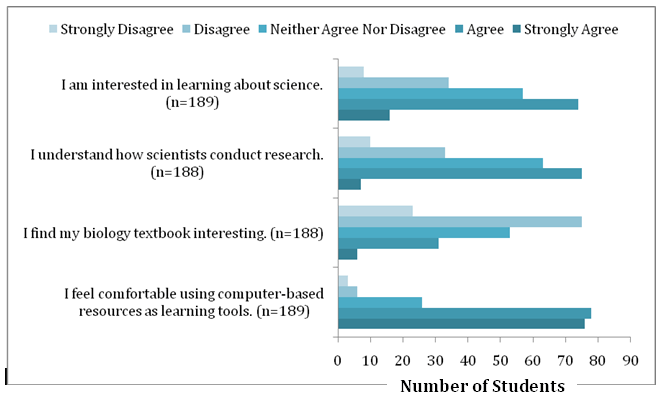
Figure 4. Post-Study Survey Responses
We have only measured learning outcomes data for the CHANCE modules for a short time, so our next research project will involve a longitudinal study to determine whether the stronger learning outcomes among high school students are attributable to the CHANCE modules and not to the novelty effect.9 New research modules specifically designed for undergraduate college students are presently under development, and we plan to assess learning outcomes of this group in the near future.
For more information on assessment of the modules, see “Blind Review of Modules.” For more on what goes into creating a research module, see “Developing a Research Module.”
Alignment with National Science Education Standards
On numerous levels the CHANCE program heeds the call for science education reform set forth by the National Science Education Standards. On the teaching front, the CHANCE program offers postsecondary teacher preparation programs a set of resources that their graduate students can use to integrate authentic research data with technology enhancement as a vehicle for learning. Each module sets the stage and provides high-quality fuel for lively discussion about scientific topics that address local and global concerns.
Each CHANCE module places a heavy emphasis on students’ development of inquiry abilities. The environmental themes allow for easy integration of other subject matter disciplines such as geology, ecology, math, statistics, and chemistry. In a time when most education budgets do not allow for many laboratory or field inquiries, the CHANCE modules offer an affordable way for students to investigate science and develop their own explanations for the results they produce. The modules promote such science process skills as communicating and analyzing data and making scientific arguments. These skills are vital for high school students through postgraduate science teacher candidates to master.
College and high school science programs can benefit from the CHANCE modules not only because they are freely available online and support state and national standards but also because they address environmental issues of increasing interest to today’s youth. Further, the modules reduce dependence on textbooks and lectures, encouraging a more student-centered approach to learning.
Next Steps: Strengthening High School to Undergraduate Links
The two most crucial elements of the CHANCE program, the active learning field-based course and the technology-enhanced research-based modules, offer biology instructors from high school through graduate school an up-to-date alternative to traditional professional development and curriculum opportunities. The CHANCE program continues to evolve, however, based on ongoing research and evaluation findings. We are developing new CHANCE modules specifically for undergraduate college students majoring in biology. These new modules will use the existing structure and format to bring real-world research directly into the college classroom, but coverage will include the key concepts needed at the collegiate level in evolution, biodiversity, cell biology, developmental biology, molecular biology, ecology, and so on.
A well-known approach to undergraduate education involves direct mentoring by a scientist, allowing an undergraduate to work in a scientist’s lab to perform hands-on research. Using this approach, students engage in many of the same activities and critical-thinking processes as scientists, such as making observations, formulating questions, gathering evidence, interpreting reproducible data, and communicating results. These apprenticeship-based and authentic research experiences generally take place outside the normal course, however, and only a handful of students can actually be mentored at this level by a research-oriented faculty member. I have no doubt that we will be able teach biology at the highest level of inquiry to more students by engaging them in real-world research through the use of technology.
Additionally, I am currently designing an interdisciplinary short-term (embedded) field course in China.10 The link between China’s booming economy and deteriorating environment makes it the perfect place for both science and economics students in the United States to learn firsthand what it really means to be a citizen of the world. Business and biology students will travel to Jiangsu Province in May 2010 to study air and water pollution, energy use and sources, and biodiversity realities. This area of China has long been the country’s most populated, affluent, and educated region. However, its highly industrialized economy has made it a testing ground for Chinese efforts to create an environmentally sustainable development model.
The China program illustrates the potential of the CHANCE model going forward. The field component consists of students carrying out a two-week practicum to study and perform hands-on research alongside academics, field scientists, governmental leaders, and more importantly, Chinese students from Nanjing University, Jiangnan University, and established sites like Lake Tai and the Yangtze River in Jiangsu Province. (See the itinerary on the Penn State Lehigh Valley site.) Students will be guided by Chinese and American faculty and Chinese government officials through a program of field-based research activities that focus on environmental issues like eutrophication (oxygen death) of China’s third-largest fresh water body, Lake Tai (see Figure 5); the pollution of the Yangtze River due to industrial waste; and urban planning problems confronting the massively industrialized area of Wuxi.

Figure 5. Pollution of Lake Tai
Closing Thoughts
As a biology educator, my vision for higher education includes real-world scientific activities and exchanges that are relevant, state-of-the-art, and based on relationships, whether local, state, national, or international. Additionally, I see the importance of teaching and research collaborations with faculty and scientists from all over the world for the purpose of creating learning environments wherein students, at any level, are inspired by doing actual research.
Technology can help bridge the gap between research and teaching. Technology allows educators to reimagine programs and pedagogical tools for the 21st century that enable teachers and their students to engage in real-world scientific research and essentially conquer higher-order inquiry in the classroom. By “doing” actual science in the classroom, both teachers and students gain a stronger understanding of the process, the methods, the struggles, the triumphs, the time commitment, and the potential discoveries of the enterprise known as science. The future of science education and the sustainability of our living world depend on this understanding.
In closing, I’m reminded of the cultural importance of science education, not just to students but to society as a whole. Consider the following excerpt from “Why America Is Flunking Science” by Chris Mooney and Sheril Kirshenbaum11:
It [science] is simultaneously admired and yet viewed as dangerously powerful and slightly malevolent — an uneasiness that comes across repeatedly in Hollywood depictions. As science-fiction film director James Cameron (“Aliens,” “Terminator,” “Titanic”) has observed, the movies tend to depict scientists “as idiosyncratic nerds or actively the villains.” That’s not only unfair to scientists: it’s unhealthy for the place of science in our culture — no small matter at a time of climate crisis, bioweapon threats, pandemic diseases and untold future controversies that will surely erupt as science continues to dramatically change our world and our politics. To begin to counter this problem, though, we need to wake up to a new recognition: Fixing the problem of science education in our schools, although very important, is not the sole solution. We also have to do something about the cultural standing of science — heavily influenced by politics and mass media — and that’s a very different matter.
All science educators must deal with the abundance of rampant misinformation, not to mention powerful social beliefs that students often stubbornly retain. But it’s not our place as educators to force scientific information onto our students. Instead, we must figure out the best ways to intellectually challenge them and allow them to experience the wonder of scientific inquiry. Well-designed interactive technology is proving to be one of the best ways to do just that. By creating and implementing learner-centered interactive environments that allow teachers and their students to engage in real-world scientific research, we can help students not only gain a stronger understanding of the scientific process but also the social impact of science worldwide.
Acknowledgments
For support of my visions, I thank my colleagues and entrusted friends from NABT, Dr. Patricia Waller, Professor Pamela Tabery, Dr. John Moore, Dr. Donald French, and the late Drs. Jerry Waldvogel and Neil Campbell, and from Penn State, Drs. John Harwood, Lewis Jillings, Richard Alley, and Stam Zervanos. For support in the jungles and the beaches of Costa Rica and now Panama, I thank Dr. Kathleen Fadigan for her expertise and devotion to field-based experiential teaching and learning. For belief in CHANCE and its impact, I want to thank Dr. Patricia Vathis (PDE), Mrs. Ellyn Schindler (sanofi pasteur), and Mr. James Bus (ATAS International, Inc.), and all other partners, sponsors, and collaborators for their endorsement and backing. For the amazing assistance with module development and design, I am beholden to all the CHANCE high school teacher authors, research scientist mentors, and multimedia design specialists who used their talents to help create a different type of pedagogical tool. I also want to thank Dr. John Morrill, New College of USF, from whom I, and many other biology faculty in this nation, learned how to teach biology using research as the key ingredient to student learning. I remain devoted to The Pennsylvania State University, which has accepted and come to celebrate engaged scholarship and allows its faculty to shine in this distinct and evolving dimension of scholarly expression.12
- Arthur W. Chickering and Zelda F. Gamson, “Seven Principles for Good Practice in Undergraduate Education,” AAHE Bulletin, vol. 39, no. 7 (March 1987), pp. 3–7; Charles C. Bonwell and James A. Eison, “Active Learning: Creating Excitement in the Classroom,” ERIC Digest, ASHE-ERIC Higher Education Report No. 1, September 1991; and Chet Meyers and Thomas B. Jones, Promoting Active Learning: Strategies for the College Classroom (San Francisco: Jossey-Bass, 1993).
- Stam. M. Zervanos and Jacqueline S. McLaughlin, “Teaching Biodiversity and Evolution Through Travel Course Experiences,” The American Biology Teacher, vol. 65, no. 9 (November/December 2003), pp. 683–688.
- Jacqueline S. McLaughlin and D. Kent Johnson, “Assessing the Field Course Experiential Learning Model: Transforming Collegiate Short-term Study Abroad Experiences into Rich Learning Environments,” Frontiers,vol. XIII(November 2006), pp. 65–85.
- See the Wikipedia entry on Bloom’s Taxonomy and A Taxonomy for Learning, Teaching, and Assessing: A Revision of Bloom’s Taxonomy of Education Objectives, Abridged Edition, Lorin W. Anderson and David R. Krathwohl, eds. (Allyn and Bacon, December 2000).
- Johan von Wright, “Reflections on Reflection,” Learning and Instruction, vol. 2, no. 1 (March 1992), pp. 59–68.
- McLaughlin and Johnson, “Assessing the Field Course Experiential Learning Model.”
- Robert L. DeHaan, “The Impending Revolution in Undergraduate Science Education,” Journal of Science Education and Technology, vol. 14, no. 2 (June 2005), pp. 253–269.
- Jacqueline S. McLauglin, “A Multimedia Learning Tool That Allows High School Teachers and Their Students to Engage in Scientific Research,” Technology Leadership in Teacher Education: Integrated Solutions and Experiences, Junko Yamamoto, Chris Penny, Joanne Leight, and Sally Winterton, eds. (Hershey, PA: IGI Global, in press, 2010).
- Karen Bauer, “Conducting Longitudinal Studies,” New Directions for Institutional Research, vol. 2004, no. 121 (March 2004), pp. 75–90.
- Jacqueline S. McLaughlin, Nikolaos Tzafaras and John McCollough, “Designing an Interdisciplinary Short-Term Program in China,” International Educator, (March/April 2008), pp. 65–70.
- Chris Mooney and Sheril Kirshenbaum, “Why America Is Flunking Science,” Salon.com, July 13, 2009. Encouragingly, Cameron’s film “Avatar,” released after the Salon.com article was published, shows scientists in a more positive, even heroic, light.
- See Ernest Boyer’s work, Scholarship Reconsidered: Priorities of the Professoriate (Menlo Park, CA: Carnegie Foundation for the Advancement of Teaching, 1990), p. 147, and “The Scholarship of Engagement,” Journal of Public Service & Outreach, vol. 1, no. 1 (Spring 1996), pp. 11–20. See also the Scholarship of Engagement website.
© 2010 Jacqueline S. McLaughlin. The text of this article is licensed under the Creative Commons Attribution-Noncommercial-No Derivative Works 3.0 license.

